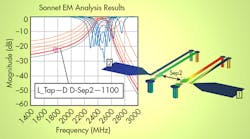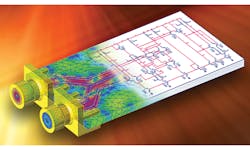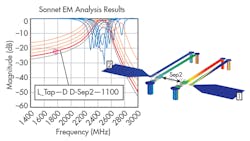This file type includes high resolution graphics and schematics when applicable.
At one time, RF engineers were resigned to fabricating several iterations or “takes” of a circuit design before fixing all the flaws and achieving expected performance levels. With modern electromagnetic (EM) simulation software, however, designers can predict the performance of their circuits down to the impedances and connections between circuit elements on a printed-circuit board (PCB), so that the design can be fabricated successfully the first time.
EM simulators have advanced from mere curiosities to dependable design tools. With their capabilities to characterize the EM fields in and around circuit components and PCBs, and to design circuits using qualified models of circuit components and PCB materials, these software tools are now design necessities for many RF/microwave engineers. They are helping to eliminate or at least minimize all those extra prototyping steps once associated with fine-tuning a high-frequency circuit design, by allowing designers to perform fine-tuning of a circuit on a personal computer (PC) loaded with a choice of EM simulation software. Many excellent commercial EM software tools are currently available, as software modules within multiple-function computer-aided-engineering (CAE) software suites and as stand-alone EM simulators. The choice depends on the demands of each application.
EM simulation software is based on three different technology approaches, all relying on the solution of Maxwell’s equations for a particular EM structure: the finite-element method (FEM), the method of moments (MoM), and the finite-difference-time-domain (FDTD) method. All three approaches are effective for a wide range of EM circuit and system simulation challenges but, as with any other high-frequency CAE software tool, an EM simulator is only as good as the models it uses.
Modeling Methods
These three EW simulation numerical modeling methods (there are more) apply different techniques to arrive at the same solution. The FDTD method operates in the time domain while the FEM and MoM approaches work in the frequency domain. This means that the FDTD method represents a structure to be analyzed by means of a number of equations for the EM field patterns around and through the structure, and solves for these equations in discrete steps in time. The FEM approach solves for differential equations representing the characteristics of the EM fields around a component and its interconnecting circuitry, dividing the structure of a component to be analyzed into finite elements. Linear equations solve for the scalar or vector electrical potential differences between elements, with large components resulting in larger volumes to be modeled and larger numbers of equations to be solved.
For EM simulators based on the FDTD numerical modeling approach, Maxwell’s equations are solved directly in the time domain, which allows relatively fast solution of larger electrical problems, such as antennas. This EM analysis approach has also shown to be effective for solving broadband as well as ultrawideband (UWB) circuit designs in a single run, rather than having to execute multiple iterations of an analysis to achieve a final result. An FDTD simulator can provide a great deal of deal in a single modeling pass, including EM near-field and far-field results in the same simulation run.
A great deal of research has been performed to compare the different numerical modeling methods for EM simulation and analysis, without any clear superiority evident for any one method. In all cases, the requirements of a particular application will help decide which of the numerical methods is a better fit for that application. Some researchers have concluded that both the FEM and FDTD methods provide great deal for small electrical problems while EM simulators based on MoM techniques will require less computer processing power and time to solve for electrically large EM analysis problems, such as antennas. Others have found that FDTD-based EM simulators can also do quite well when modeling electrically large designs, depending upon the application and the circuit materials, so there is no clear choice for an EM simulator based on these numerical solution approaches.
Choice of Tools
As noted, EM simulators can be found as integrated modules within suites of software simulators or as dedicated software programs that allow a user to focus just on performing an EM simulation. An example of the former case is the popular Advanced Design System (ADS) software suite from Keysight Technologies, which contains the firm’s EMPro full three-dimensional (3D) EM simulation software and Momentum 3D planar EM simulation software programs. The full 3D EM simulation software provides the means for analyzing the EM fields around all the dimensions of an electrical structure, such as a connector (Figs. 1 and 2) while a 3D planar EM simulator is an effective tool for studying the EM field responses along the surface of a circuit or through a microstrip or stripline transmission line. In addition to these EM simulators, the ADS software suite boasts a host of circuit and system simulation software tools, circuit and system optimization tools, an electro-thermal simulator to analyze thermal effects in designs, access to extensive libraries of models, and connectivity to the company’s extensive lines of test equipment.
This capability to work with different test equipment, such as microwave vector network analyzers (VNAs), makes it possible to capture component S-parameters for building new EM models when needed. ADS also works with the firm’s EMPro software, a separate, dedicated 3D EM modeling and simulation tool. Tight compatibility between ADS and EMPro allows objects and models modeled and analyzed in EMPro to be saved in ADS libraries for use by other software programs. In addition, EMPro contains some practical functions for circuit designers, such as the capability to draw structures and create arbitrary 3D shapes and structures for EM analysis. The program offers the unique capability to shift from its normal FEM technology basis to the use of FDTD technology when modeling and analyzing electrically large structures, such as antennas.
Similarly, the NI AWR Design Environment from National Instruments, with its popular Microwave Office suite of software design tools, combines a large number of modeling and simulation software program modules within a single PC package. The software suite, developed by Applied Wave Research (AWR) which was acquired by National Instruments, includes circuit schematic and layout design, linear and nonlinear circuit simulation, and EM simulation.
The EM simulators, the AXIEM and Analyst software programs, combine for many noteworthy features, including a function known as Automatic Circuit Extraction (ACE) which reduces the time to model circuits transferred from layout programs by automatically identifying transmission lines and interconnections and assigning best-case models for a simulation. The NI AWR Design Environment software collection also includes the Visual System Simulator software for system simulation and Analog Office for analog circuit design. As with the Keysight Technologies software simulation suite, this software suite is compatible with the company’s many lines of test instruments to aid in modeling and analysis.
A firm long associated with EM simulation solutions as well as with Maxwell and his equations, Sonnet Software, offers EM simulation software rather than on integrated collections of different software programs. The firm’s Sonnet Suites provide 3D EM planar analysis of different electronic structures, including PCBs and their interconnections, allowing users to work with files from popular circuit layout programs for modeling purposes as well as to create circuit and component models with internal layout tools. The Sonnet Suites can model and analyze single- and multiple-layer PCBs on different circuit-board materials as well as the viaholes that interconnect the circuit layers (Fig. 3).
The Sonnet Suites feature tight compatibility with other companies’ software tools, including the ADS tools from Keysight Technologies and the AWR Microwave Office suite of simulators from National Instruments. In addition to the Sonnet Suites, the company offers Blink, an EM simulator tailored for the design of passive circuit elements on integrated circuits (ICs), and SonnetLite, a free, scaled-down version of the Sonnet Suites EM simulator software.
Another firm long associated with EM simulation, ANSYS, also offers a software tool dedicated to EM simulation, in the form of its High Frequency Structure Simulator (HFSS) software. This full-wave 3D EM analysis tool is well known for its capabilities in modeling the lowest-frequency circuits, such as power supplies, through the highest-frequency designs, at millimeter-wave frequencies. The EM simulator can actually combine multiple numerical modeling methods (FEM and MoM) to achieve the most accurate solutions of EM field equations in the shortest computational time possible. A user can select a numerical solution approach for a given design and the software program will automatically generate a mesh for solving the design’s EM field equations. The EM simulation software even incorporates a linear circuit simulator to aid with designing and modifying matching networks when optimizing the performance of a design. The EM simulator is fully compatible with commercial electronic design automation (EDA) software programs such as tools from Cadence Design Systems for the design of analog and digital ICs.
Remcom also offers a software tool dedicated to EM simulator, now available in Release 7.5: the XFdtd EM simulation software. Based on FDTD numerical analysis, the latest release of this EM simulator features a new circuit element optimizer module (for such circuit elements as resistors, capacitors, and inductors) to speed the matching of antennas for portable communications devices, including such affects as whether an antenna is being held in a user’s hand or the effects of being near a user’s hand. This represents a complex modeling challenge, given the dielectric variations represented by a human hand (Fig. 4), but modeling information that can impact the performance of active electronics as well as a portable communication device’s antenna. This simulator has been used for a wide range of commercial, industrial, and military simulation tasks, from optimizing the impedance matching of wireless antennas to the modeling of ground-penetrating-radar (GPR) systems.
Integrated Engineering Software has developed a number of different simulation engines, including for EM and magnetic-field simulation and analysis. Some of their software tools operate with three or more numerical solvers, including their own boundary element method (BEM) which is effective in modeling the EM fields in the space around a component or transmission line. By combining different solvers, such as BEM, FEM, and FDTD, within the same EM simulator, hybrid solution approaches can be employed which combine the capabilities of the different field solvers.
For any RF/microwave engineer interested in learning more about the rewards of using an EM simulator as part of the high-frequency design process, an excellent starting place is the Sonnet Software website and SonnetLite, a free EM simulation software program. Although this is a feature-limited version of the firm’s powerful Sonnet Suites 3D planar EM simulation tools, it is quite capable of performing analysis on a wide variety of RF/microwave circuits. The firm also provides a 150-page “Getting Started” guide to the Sonnet Suites for free download. It is a useful educational tool on EM simulation in general and in learning how to use the Sonnet software, including SonnetLite, in particular. In addition to this and other free EM simulation software tools available from different firms, many EM simulator suppliers provide demonstration version of their software. These are either programs limited in function, or software that provides full analysis and simulation functionality but is usable only for a short time. For example, Keysight Technologies is currently offering free trials of its various software programs, including the ADS software suite with its EM simulators and the system-level simulator SystemVue. Also, ANSYS offers complimentary copies of its ANSYS Student software for educational purposes. In all cases, EM simulation software is a useful tool for RF/microwave circuit and system design, and is steadily becoming a larger part of many high-frequency engineers’ design routines.
This file type includes high resolution graphics and schematics when applicable.





